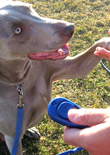Has Clickertraining Revolutionized the Dog Training World?
By Sally Gutteridge | Posts

 Today, clickertraining is used as a popular, effective, and gentle training method for dogs. However, operant conditioning – the process of training any animal with a clicking mechanism – has been used as a positive reinforcement training tool since World War II by B.F. Skinner.1
Today, clickertraining is used as a popular, effective, and gentle training method for dogs. However, operant conditioning – the process of training any animal with a clicking mechanism – has been used as a positive reinforcement training tool since World War II by B.F. Skinner.1
The training method uses a perceived signal in a consistent pattern so that an animal can repeat their behavior or learn a trick through positive reinforcement. Although this training method is popular with dogs today, it has been used with dolphins, birds, and even goldfish by substituting a whistle or a flashlight for a traditional clicker. Even deaf dogs can use clickertraining with a vibrating collar.
Today, one of the leaders in clickertraining is Karen Pryor, who has helped to introduce the training method to the dog training world. Pryor is a scientist in both behavioral psychology and marine biology and has practiced operant conditioning by working hands-on as a dolphin trainer in the 1960s.
Pryor emphasizes that the importance of clickertraining for dogs is to provide a modern animal training method that does not use force or punishment.
The History of Clickertraining
According to clickertraining expert Pryor, clickertraining for dogs is an application of behavioral analysis that was developed close to 50 years ago by Keller Breland and Marian Breland Bailey, students of B.F. Skinner.2
Clickertraining first became popularized to train marine mammals using a whistle. The methodology was not made known to the general public until the early 90s when Pryor hosted the first Don’t Shoot the Dog! seminar for clickertraining. At that time, there was not a single dog trainer using clickertraining. However, today, thanks to the innovations of Pryor, over 10,000 dog trainers now rely on clickertraining as a primary training tool.
There are three main reasons that the technology of clickertraining has spread so rapidly in the dog training community:
This means that expert dog trainers and everyday dog owners alike can use clickertraining to teach their dogs tricks and reinforce good behavior. For the many people that believe that their dogs are not smart or capable enough to learn tricks, clickertraining makes a significant impact and changes even the most disobedient dogs’ behaviors dramatically.
Sources:
Session expired
Please log in again. The login page will open in a new tab. After logging in you can close it and return to this page.